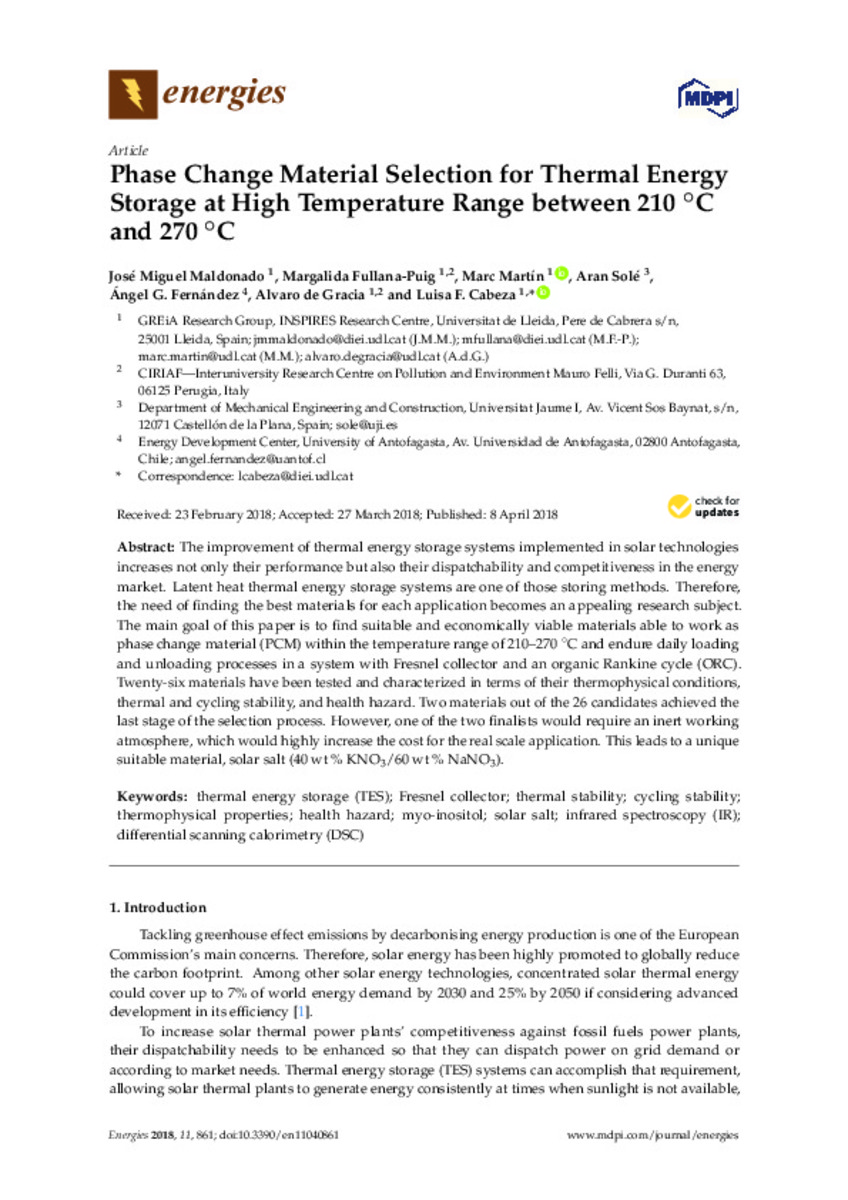Mostrar el registro sencillo del ítem
Phase Change Material Selection for Thermal Energy Storage at High Temperature Range between 210 degrees C and 270 degrees C
| dc.contributor.author | Maldonado, José Miguel | |
| dc.contributor.author | Fullana-Puig, Margalida | |
| dc.contributor.author | Martín Llop, Marc | |
| dc.contributor.author | Solé, Aran | |
| dc.contributor.author | Fernández, Ángel G. | |
| dc.contributor.author | De Gracia, Álvaro | |
| dc.contributor.author | CABEZA, LUISA F. | |
| dc.date.accessioned | 2018-11-12T11:42:47Z | |
| dc.date.available | 2018-11-12T11:42:47Z | |
| dc.date.issued | 2018-04-08 | |
| dc.identifier.citation | MALDONADO, José Miguel; FULLANA-PUIG, Margarida; MARTÍN, Marc; SOLÉ, Aran; FERNÁNDEZ, Ángel G.; DE GRACIA, Álvaro; CABEZA, Luisa F. (2018). Phase Change Material Selection for Thermal Energy Storage at High Temperature Range between 210 degrees C and 270 degrees C. Energies, v. 11, n. 4 | ca_CA |
| dc.identifier.uri | http://hdl.handle.net/10234/177332 | |
| dc.description.abstract | The improvement of thermal energy storage systems implemented in solar technologies increases not only their performance but also their dispatchability and competitiveness in the energy market. Latent heat thermal energy storage systems are one of those storing methods. Therefore, the need of finding the best materials for each application becomes an appealing research subject. The main goal of this paper is to find suitable and economically viable materials able to work as phase change material (PCM) within the temperature range of 210–270 ◦ C and endure daily loading and unloading processes in a system with Fresnel collector and an organic Rankine cycle (ORC). Twenty-six materials have been tested and characterized in terms of their thermophysical conditions, thermal and cycling stability, and health hazard. Two materials out of the 26 candidates achieved the last stage of the selection process. However, one of the two finalists would require an inert working atmosphere, which would highly increase the cost for the real scale application. This leads to a unique suitable material, solar salt (40 wt % KNO 3 /60 wt % NaNO 3 ). | ca_CA |
| dc.format.extent | 13 p. | ca_CA |
| dc.format.mimetype | application/pdf | ca_CA |
| dc.language.iso | eng | ca_CA |
| dc.publisher | MDPI | ca_CA |
| dc.relation.isPartOf | Energies (2018), v. 11, n. 4 | ca_CA |
| dc.rights | Atribución 4.0 Internacional | * |
| dc.rights.uri | http://creativecommons.org/licenses/by-sa/4.0/ | * |
| dc.subject | Thermal energy storage (TES) | ca_CA |
| dc.subject | Fresnel collector | ca_CA |
| dc.subject | Thermal stability | ca_CA |
| dc.subject | Cycling stability | ca_CA |
| dc.subject | Thermophysical properties | ca_CA |
| dc.subject | Health hazard | ca_CA |
| dc.subject | Myo-inositol | ca_CA |
| dc.subject | Solar salt | ca_CA |
| dc.subject | Infrared spectroscopy (IR) | ca_CA |
| dc.subject | Differential scanning calorimetry (DSC) | ca_CA |
| dc.title | Phase Change Material Selection for Thermal Energy Storage at High Temperature Range between 210 degrees C and 270 degrees C | ca_CA |
| dc.type | info:eu-repo/semantics/article | ca_CA |
| dc.identifier.doi | https://doi.org/10.3390/en11040861 | |
| dc.rights.accessRights | info:eu-repo/semantics/openAccess | ca_CA |
| dc.relation.publisherVersion | https://www.mdpi.com/1996-1073/11/4/861 | ca_CA |
| dc.contributor.funder | 1) uropean Union’s Horizon 2020 Research & Innovation Programme under Grant Agreement 723596 with reference name Innova MicroSolar; 2) Ministerio de Econom í a y Competitividad de España (ENE2015-64117-C5-1-R (MINECO/FEDER) and ENE2015-64117-C5-3-R (MINECO/FEDER)); 3) Catalan Government for the quality accreditation given to their research group (2017 SGR 1537); 4) panish Government for his research fellowship (BES-2016-076554); 5) Ministerio de Econom í a y Competitividad de España for Grant Juan de la Cierva, FJCI-2015-25741; 6) European Union’s Horizon 2020 research and innovation programme under the Marie Sklodowska-Curie grant agreement No. 712949; 7) GIZ “Programa de pasant í a en el extranjero en tecnolog í as de concentraci ó n solar para investigadores” and CONICYT/FONDAP 15110019 “Solar Energy Research Center” SERC-Chile. | ca_CA |
| dc.type.version | info:eu-repo/semantics/publishedVersion | ca_CA |
Ficheros en el ítem
Este ítem aparece en la(s) siguiente(s) colección(ones)
-
EMC_Articles [803]








